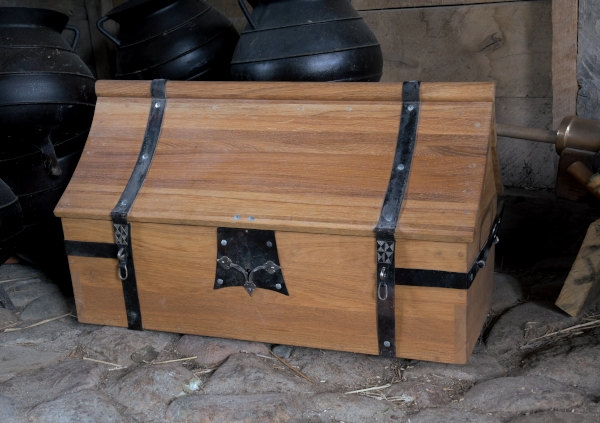
To store and keep accessories and bullets ready at the place of action, there were artillery chests. These chests usually had different compartments for the accessories, bullets and powder supplies or Hultzein Ladungen, small wooden containers with single powder loads. Some of these compartments had additional lids to cover them.
The war book of Eyb zum Hartenstein suggests that for each rifle or at least for each gun there were individual chests for their accessories. These chests were marked with the individual rifle mark for identification.1) Most of the chests were relatively simple and functional, some were painted with a protective coating and only a few were decorated and bore e.g. painted coats of arms. Many chests had roof-shaped lids to provide better protection against rain in the field. The contemporary illustrations show that all weapon chests were locked with locks or with iron bands and padlocks. Some were even equipped with several locking options to restrict access to the contents of the chest, so that the chest could only be opened jointly by several key holders. In the event of a battle, for example, a gunmaster or other superior could release the chest by removing the padlocks so that the gunner could open it with his key.
Reconstruction
Our artillery chest is made of oak and its outer form with the pagoda roof, including iron bands and interior decoration, is based on illustrations in Eyb zum Hartenstein1), the Landshut arsenal inventory of Ulrich Beßnitzer2) and the so called Weimarer Ingenieurskunst- und Wunderbuch (litereally: Weimar Book of Engineering Arts and Wonders).3) The central lock of the chest as well as the decoration of the hasps and key slide are based on a chest from Lübeck.4) The corresponding key corresponds to a find from the excavations on Schloßstraße in Hamburg-Harburg.5) The chest is equipped with three locking options: the central lock, whose key is held by the shooter, and two additional hasps for padlocks.
The chest was carpented by Robert Wenta, iron bands, lock and key is from Fabian Griesler-Nohe of Slos vn sluessel.

Ingenieurkunst- und Wunderbuch. Süddeutschland um 1520. Herzogin Anna Amalia Bibliothek Weimar, Fol 328, S. 4443)
Two weapon chests from Eyb zum Hartenstein: Kriegsbuch, um 1500, Fol. 276r1)
Key, found at Harburger Schloßstraße in Hamburg-Harburg5)
Lock with hasps from Lübeck4)
References
- Eyb zum Hartenstein (1500): Fol. 276r
- Beßnitzer (1485)
- (sog. Weimarer) Ingenieurkunst- und Wunderbuch (um 1520)
- St. Annen Museum Lübeck, inv. No. 1935-293
- Weiss (2017), pp. 34-35
Text: Andreas Franzkowiak, Chris Wenzel; Potos: Fabian Griesler-Nohe, Andreas Franzkowiak and cieted sources.







